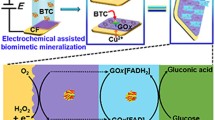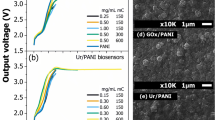Abstract
Dual-responsive poly(N,N-diethylacrylamide) (PDEA) hydrogel films with entrapped horseradish peroxidase (HRP) and glucose oxidase (GOD) were successfully prepared on electrode surface with a simple one-step polymerization procedure under mild conditions, designated as PDEA-HRP-GOD. Cyclic voltammetric (CV) response of electroactive probe K3Fe(CN)6 at the film electrodes displayed reversible thermo- and sulfate-responsive switching behavior. For example, at 25 °C, the K3Fe(CN)6 demonstrated a well-defined CV peak pair with large peak currents for the films, showing the on state, while at 40 °C, the CV response was greatly suppressed and the system was at the off state. The influence of temperature and Na2SO4 concentration on the switching behavior of the film system was not independent or separated, but was synergetic. The responsive mechanism of the system was ascribed to the structure change of PDEA component in the films with temperature and sulfate concentration. This switching property of the PDEA-HRP-GOD films could be further used to realize dual-responsive catalytic oxidation of glucose sequentially by HRP and GOD entrapped in the films with Fe(CN)6 3− as the mediator through changing the surrounding temperature and Na2SO4 concentration. This system may establish a foundation for fabricating a new type of multi-switchable electrochemical biosensors based on bienzyme electrocatalysis.







Similar content being viewed by others
References
Scheller, F. W., Wollenberger, U., Warsinke, A., & Lisdat, F. (2001). Research and development in biosensors.Current Opinion Biotechnology, 12, 35–40.
Chaubey, A., & Malhotra, B. D. (2002). Mediated biosensors.Biosensors and Bioelectronics, 17, 441–456.
Murphy, L. (2006). Biosensors and bioelectrochemistry.Current Opinion in Biotechnology, 10, 177–184.
Conrado, R. J., Varner, J. D., & Delisa, M. P. (2008). Engineering the spatial organization of metabolic enzymes: mimicking nature's synergy.Current Opinion Biotechnology, 19, 492–499.
Shi, J., Cha, T.-G., Claussen, J. C., Diggs, A. R., Choi, J. H., & Porterfield, D. M. (2011). Microbiosensors based on DNA modified single-walled carbon nanotubeand Pt black nanocomposites.Analyst, 136, 4916–4924.
Gamella, M., Campuzano, S., Conzuelo, F., Curiel, J. A., Munoz, R. A., Reviejo, J., & Pingarrón, J. M. (2010). Integrated multienzyme electrochemical biosensors for the determination of glycerol in wines.Talanta, 81, 925–933.
Nieh, C., Kitazumi, Y., Shirai, O., & Kano, K. (2013). Sensitive d-amino acid biosensor based on oxidase/peroxidase system mediated by pentacyanoferrate-bound polymer.Biosensors and Bioelectronics, 47, 350–355.
Loaiza, O. A., Laocharoensuk, R., Burdick, J., Rodriguez, M. C., Pingarron, J. M., Pedrero, M., & Wang, J. (2007). Adaptive orientation of multifunctional nanowires for magnetic control of bioelectrocatalytic processes.Angewandte Chemie International Edition, 119, 1530–1533.
Willner, I., & Katz, E. (2003). Magnetic control of electrocatalytic and bioelectrocatalytic processes.Angewandte Chemie International Edition, 42, 4576–4588.
Tam, T. K., Strack, G., Pita, M., & Katz, E. (2009). Biofuel cell controlled by enzyme logic systems.Journal of the American Chemical Society, 131, 11670–11671.
Katz, E., & Privman, V. (2010). Enzyme-based logic systems for information processing.Chemical Society Reviews, 39, 1835–1857.
Yao, H., & Hu, N. (2011). Triply responsive films in bioelectrocatalysis with a binary architecture: combined layer-by-layer assembly and hydrogel polymerization.Journal of Physical Chemistry B, 115, 6691–6699.
Tam, T. K., Ornatska, M., Pita, M., Minko, S., & Katz, E. (2008). Polymer brush-modified electrode with switchable and tunable redox activity for bioelectronic applications.Journal of Physical Chemistry C, 112, 8438–8445.
Song, S., & Hu, N. (2010). “On−off” switchable bioelectrocatalysis synergistically controlled by temperature and sodium sulfate concentration based on poly(N-isopropylacrylamide) films.Journal of Physical Chemistry B, 114, 5940–5945.
Katz, E., & Willner, I. (2003). A biofuel cell with electrochemically switchable and tunable power output.Journal of the American Chemical Society, 125, 6803–6813.
Blonder, R., Katz, E., Willner, I., Wray, V., & Buckmann, A. F. (1997). Application of a nitrospiropyran-FAD-reconstituted glucose oxidase and charged electron mediators as optobioelectronic assemblies for the amperometric transduction of recorded optical signals: control of the “on”−“off” direction of the photoswitch.Journal of the American Chemical Society, 119, 11747–11757.
Hirsch, R., Katz, E., & Willner, I. (2000). Magneto-switchable bioelectrocatalysis.Journal of the American Chemical Society., 122, 12053–12054.
Liang, Y., Song, S., Yao, H., & Hu, N. (2011). Triply switchable bioelectrocatalysis based on poly(N-isopropylacrylamide) hydrogel films with immobilized glucose oxidase.Electrochimica Acta, 56, 5166–5173.
Song, S., & Hu, N. (2010). Dual-switchable bioelectrocatalysis synergistically controlled by pH and perchlorate concentration based on poly(4-vinylpyridine) films.Journal of Physical Chemistry B, 114, 11689–11695.
Liang, Y., Liu, H., Zhang, K., & Hu, N. (2012). Triply switchable bioelectrocatalysis based on poly(N, N-diethylacrylamide-co-4-vinylpyridine) copolymer hydrogel films with immobilized glucose oxidase.Electrochimica Acta, 60, 456–463.
Zhang, K., Liang, Y., Liu, D., & Liu, H. (2012). An on-off biosensor based on multistimuli-responsive polymer films with a binary architecture and bioelectrocatalysis.Sensors & Actuators B: Chemical, 173, 367–376.
Liu, D., Liu, H., & Hu, N. (2012). pH-, suger-, and temperature-sensitive electrochemical switch amplified by enzymatic reaction and controlled by logic gates based on semi-interpenetrating polymer networks.Journal of Physical Chemistry B, 116, 1700–1709.
Maeda, Y., Yamamoto, H., & Ikeda, I. (2001). Effects of ionization of incorporated imidazole groups on the phase transitions of poly(N-isopropylacrylamide), poly(N, N-diethylacrylamide), and poly(N-vinylcaprolactam) in water.Langmuir, 17, 6855–6859.
Chen, J., Liu, M., Liu, H., Ma, L., Gao, C., Zhu, S., & Zhang, S. (2010). Synthesis and properties of thermoand pH-sensitive poly(diallyldimethylammonium chloride)/poly(N, N-diethylacrylamide) semi-IPN hydrogel.Chemical Engineering Journal, 159, 247–256.
Mao, H., Li, C., Zhang, Y., Bergbreiter, D. E., & Cremer, P. S. (2003). Measuring LCSTs by novel temperature gradient methods: evidence for intermolecular interactions in mixed polymer solutions.Journal of the American Chemical Society, 125, 2850–2851.
Chen, Y., Liu, M., Bian, F., Wang, B., Chen, S., & Jin, S. (2006). The effect of NaCl on the conformational behavior of acenaphthylene labeled poly(N, N-diethylacrylamide) in dilute aqueous solution.Macromolecular Chemistry and Physics, 207, 104–110.
Panayiotou, M., & Freitag, R. (2005). Influence of the synthesis conditions and ionic additives on the swelling behavior of thermo-responsive polyalkylacrylamide hydrogels.Polymer, 46, 6777–6785.
Liu, T., Fang, J., Zhang, Y., & Zeng, Z. (2008). The effect of salt and pH on the phase transition behaviors of pH and temperature-responsive poly(N, N-diethylacrylamide-co-methylacrylic acid).Macromolecular Research, 16, 670–675.
Kulys, J. J., Pesliakiene, M. V., & Samalius, A. S. (1981). The development of bienzyme glucose electrodes.Bioelectrochemistry and Bioenergetics, 8, 81–88.
Ohara, T. J., Vreeke, M. S., Battaglini, F., & Heller, A. (1993). Bienzyme sensors based on “electrically wired” peroxidise.Electroanalysis, 5, 825–831.
Delvaux, M., Walcarius, A., & Demoustier-Champagne, S. (2005). Bienzyme HRP–GOx-modified gold nanoelectrodes for the sensitive amperometric detection of glucose at low overpotentials.Biosensors and Bioelectronics, 20, 1587–1594.
Suarez, G., Jackson, R. J., Spoors, J. A., & McNeil, C. J. (2007). Chemical introduction of disulfide groups on glycoproteins: a direct protein anchoring scenario.Analytical Chemistry, 79, 1961–1969.
Jeykumari, D. R. S., & Narayanan, S. S. (2009). Fabrication of an amperometric bienzyme biosensing system with neutral red functionalized carbon nanotubes.Analyst, 134, 1618–1622.
Chen, H., Xi, F., Gao, X., Chen, Z., & Lin, X. (2010). Bienzyme bionanomultilaye relectrode for glucose biosensing based on functional carbon nanotubes and sugar–lectin biospecific interaction.Analytical Biochemistry, 403, 36–42.
Yao, H., & Hu, N. (2010). pH-controllable on−off bioelectrocatalysis of bienzyme layer-by-layer films assembled by concanavalin A and glucoenzymes with an electroactive mediator.Journal of Physical Chemistry B, 114, 9926–9933.
Panayiotou, M., & Freitag, R. (2005). Synthesis and characterisation of stimuli-responsive poly (N, N'-diethylacrylamide) hydrogels.Polymer, 46, 615–621.
Ding, X., Fries, D., & Jun, B. (2006). A study of hydrogel therma-dynamics using Fourier transform infrared spectrometer.Polymer, 47, 4718–4725.
Chen, J., Liu, M., Liu, H., & Ma, L. (2009). Synthesis, swelling and drug release behavior of poly(N, N-diethylacrylamide-co-N-hydroxymethyl acrylamide) hydrogel.Materials Science and Engineering C, 29, 2116–2123.
Chu, L., Zou, X., Knoll, W., & Forch, R. (2008). Thermosensitive surfaces fabricated by plasma polymerization of N, N-diethylacrylamide.Surface and Coating Technology, 202, 2047–2051.
Jia, N., Zhou, Q., Liu, L., Yan, M., & Jiang, Z. (2005). Direct electrochemistry and electrocatalysis of horseradish peroxidase immobilized in sol-gel-derived tin oxide/gelatin composite films.Journal of Electroanalytical Chemistry, 580, 213–221.
Theorell, H., & Ehrenberg, A. (1951). Spectrophotometric, magnetic, and titrimetric studies on the heme-linked groups in myoglobin.Acta Chemica Scandinavica, 5, 823–848.
George, P., & Hanania, G. (1953). A spectrophotometric study of ionizations in methaemoglobin.Biochemical Journal, 55, 236–243.
Katz, E., & Willner, I. (2003). Probing biomolecular interactions at conductive and semiconductive surfaces by impedance spectroscopy: routes to impedimetric immunosensors, DNA-Sensors, and enzyme biosensors.Electroanalysis, 15, 913–947.
Sabatani, E., Rubinstein, I., Maoz, R., & Sagiv, J. (1987). Monolayer-based ultra-microelectrodes for the study of very rapid electrode kinetics.Journal of Physical Chemistry, 91, 6663–6669.
Zhang, Y., Furyk, S., Bergbreiter, D. E., & Cremer, P. S. (2005). Specific ion effects on the water solubility of macromolecules: PNIPAM and the Hofmeister series.Journal of the American Chemical Society, 127, 14505–14510.
Jeykumari, D. R. S., & Narayanan, S. S. (2008). A bienzyme channeling glucose sensor with a wide concentration range based on co-entrapment of enzymes in SBA-15 mesopores.Biosensors and Bioelectronics, 23, 1686–1693.
Patolsky, F., Zayats, M., Katz, E., & Willner, I. (1999). Precipitation of an insoluble product on enzyme monolayer electrodes for biosensor applications: characterization by faradaic impedance spectroscopy, cyclic voltammetry, and microgravimetric quartz crystal microbalance analyses.Analytical Chemistry, 71, 3171–3180.
Li, F., Wang, Z., Chen, W., & Zhang, S. (2009). A simple strategy for one-step construction of bienzyme biosensor by in-situ formation of biocomposite film through electrodeposition.Biosensors and Bioelectronics, 24, 3030–3035.
Acknowledgments
The financial support from the Natural Science Foundation of China (NSFC 21105004 and 21265015) and the Major Research Plan of NSFC (21233003) is acknowledged.
Author information
Authors and Affiliations
Corresponding author
Electronic supplementary material
Below is the link to the electronic supplementary material.
ESM 1
(DOC 1.44 MB)
Rights and permissions
About this article
Cite this article
Yao, H., Lin, L., Wang, P. et al. Thermo- and Sulfate-Controllable Bioelectrocatalysis of Glucose Based on Horseradish Peroxidase and Glucose Oxidase Embedded in Poly(N,N-diethylacrylamide) Hydrogel Films. Appl Biochem Biotechnol 173, 2005–2018 (2014). https://doi.org/10.1007/s12010-014-0987-y
Received:
Accepted:
Published:
Issue Date:
DOI: https://doi.org/10.1007/s12010-014-0987-y




